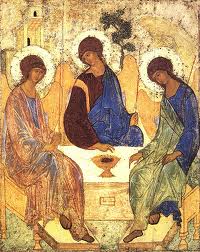|
|||
|---|---|---|---|
| This weekly bulletin insert complements the curriculum published by the Department of Christian Education of the Orthodox Church in America. This and many other Christian Education resources are available at http://dce.oca.org. | |||

The television miniseries "The Bible" prompted many comments and analyses, some eagerly praising it and others lambasting it for superficial or wrong theology. When we celebrate Palm Sunday and Holy Week we are reminded of the importance of the Old Testament. Jesus Christ's entry into Jerusalem is foretold in the prophecy of Zechariah 9:9. We also remember the prophet Jeremiah, who prophesies the birth of Christ in 23:5 (RSV translation): "Behold, the days are coming, says the Lord, when I will raise up for David a righteous Branch, and he shall reign as king and deal wisely, and shall execute justice and righteousness in the land." It isn't only in prophecies that the Church puts the Old Testament before us and relates it directly to Jesus Christ. In the penitential Canon of Saint Andrew of Crete for Thursday of the first week of Great Lent, we read this plea: "May my tears be for me a Siloam, O Sovereign Lord, that I may wash the eyes of my soul and mentally see Thee Who art that light which was before creation." This verse makes it clear that the Christ who healed a blind man by anointing his eyes with clay and then having him wash in the pool of Siloam (John 9:1-7) is the same Christ who created the universe with His Father and the Holy Spirit. One of the critics of the "Bible" miniseries is Dr. Peter Enns, who teaches Biblical Studies at Eastern University in Pennsylvania. He takes issue with the way the visit of the three angels to Abraham and Sarah (Genesis 18) is depicted. Dr. Enns says that because one of the three angelic visitors to Abraham and Sarah is addressed as "Lord" the miniseries has transformed him into a "proto-Jesus." Even though this is never clearly seen in the show, the figure is "highlighted as Christ." Then Dr. Enns goes on to say, "In the Old Testament, that's completely out of bounds." The Orthodox Church disagrees that to depict Jesus Christ in an Old Testament scene is "out of bounds." The well-known icon of the "Hospitality of Abraham" shows Abraham with the visitors, and they are the three Persons of the Holy Trinity. One of them is indeed the second Divine Person, not a "proto-Jesus" but the pre-incarnate Christ. 
Such a depiction is reliably Scriptural. In the Book of Micah 5:2, for example, there is the familiar description of Bethlehem as "little to be among the clans of Judah." But the next verses also say that this one who is to be ruler in Israel, who will come forth from Bethlehem, has his origin "from old, from ancient days." He will be active in the Old Testament, in other words. The translation in the Orthodox Study Bible makes the "active" point more strongly: "His goings forth were from the beginning, even from everlasting." Christ is always with us, and has always been. If the "Bible" miniseries gave some indication of this, in that at least it did a good thing. |
|||
